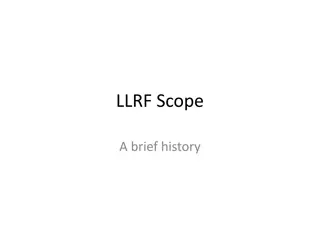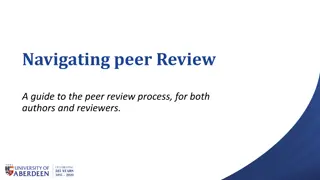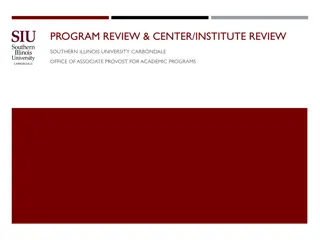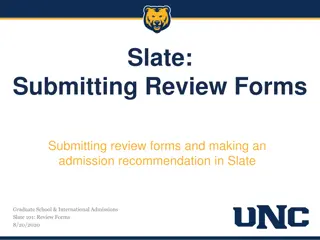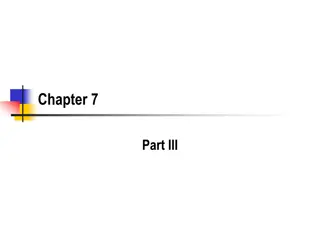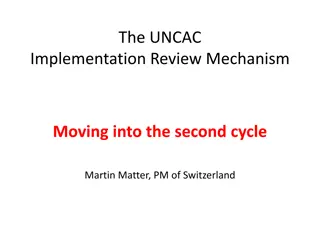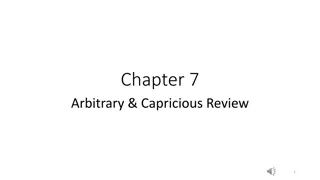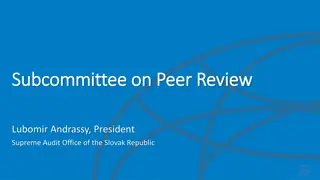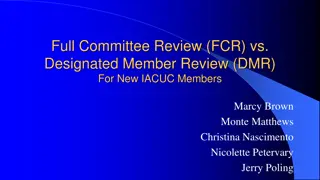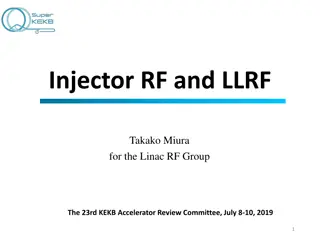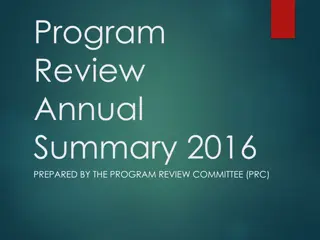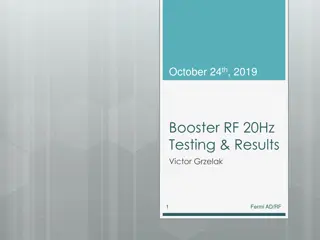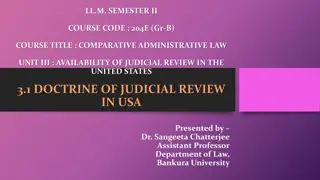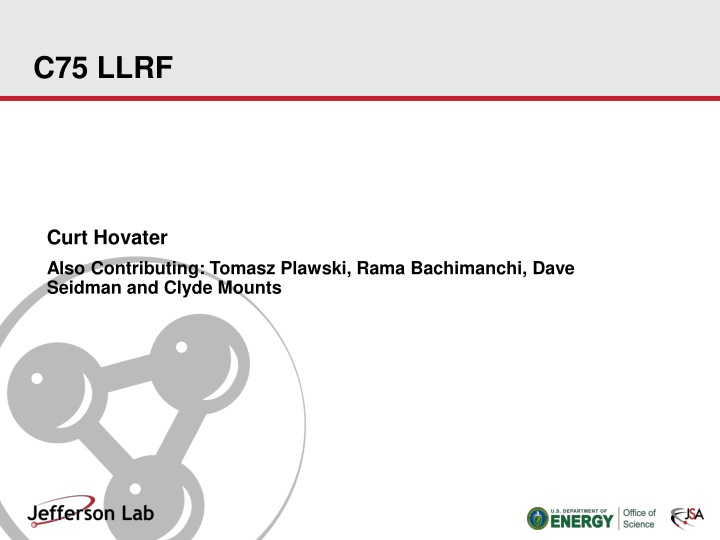
Digital LLRF System Review: Challenges and Transition Insights
Explore the journey from analog to digital LLRF systems, highlighting the issues with obsolete parts and the need for a transition to more advanced technologies. Discover the hurdles faced with continuing the current C100 LLRF design and the imperative for upgrades to enhance performance and reliability.
Download Presentation

Please find below an Image/Link to download the presentation.
The content on the website is provided AS IS for your information and personal use only. It may not be sold, licensed, or shared on other websites without obtaining consent from the author. If you encounter any issues during the download, it is possible that the publisher has removed the file from their server.
You are allowed to download the files provided on this website for personal or commercial use, subject to the condition that they are used lawfully. All files are the property of their respective owners.
The content on the website is provided AS IS for your information and personal use only. It may not be sold, licensed, or shared on other websites without obtaining consent from the author.
E N D
Presentation Transcript
C75 LLRF Curt Hovater Also Contributing: Tomasz Plawski, Rama Bachimanchi, Dave Seidman and Clyde Mounts
Outline Existing C20/50 & C100 LLRF LCLSII LLRF Path to New Digital LLRF C75 LLRF RF Front End Digitizer FPGA Carrier Interface to Controls Questions/Comments/Thoughts C75 Review February 15, 2018 2
Where We Have Been AnalogDigital Obsolete Parts Analog LLRF Circa 1992 The present Analog RF system is labor intensive to maintain and repair System has obsolete and hard to find parts Crates are dying C75s can utilize the existing analog LLRF systems but gradient and operability will be reduced because of Lorentz detuning. Analog LLRF C100 Digital LLRF System Been a workhorse But next slide C75 Review February 15, 2018 3
Unfortunately Continuing with C100 LLRF is Impossible Design is 10 years old (hard to believe) Parts are difficult to obtain or not recommended for new design/production PC104 version is not available FPGA: Cyclone Three is not for new designs ADCs are 15 year old design better components out there now Design has flaws Channel Isolation barely met specification, limiting our gain and field control Clock chip can over heat and the modification is not optimum Lack of digital board (ADC/DAC/Clock and FPGA share same board) modularity makes it difficult to upgrade PC104 while a workable solution in 2006 is now cumbersome there are better ways of doing this At the time this was a good design and digital flexibility has allowed us to make up for some of the operational C100 flaws. It has become a work horse for SRF cavity testing C75 Review February 15, 2018 4
A Sample of Obsolete Parts number Board Part Comment Attenuator TVA0200N05 RF All 4 of these attenuators are very hard to get and install. Attenuator TVA0300N03 RF Attenuator TVA0600P08 RF Attenuator TVA1000N07 RF Getting very hard to find. Will be phased out soon. FPGA - Cyclone III 3491 LABs 327 IO Obsolete. Resistor Networks & Arrays Resistor-Cap Network Chip 4 RC's 1206 Obsolete. Audio Transformers / Signal Transformers 4.5-3000MHz Imp 1:1 50 and 75 Ohm End of life. FPGA - Configuration Memory IC - Ser. Config Mem Flash 64Mb 40 MHz FPGA EP3C55F484C8 Digital Resistor EZA-DT21AAAJ Digital Transformer MABACT0034 Digital Memory EPCS64SI16N MT48LC16M16A2TG- 75:D Digital Memory Digital Obsolete. IC SDRAM 256MBIT 133MHZ 54TSOP Chad is working on a solution or we need to re-qualify another PC104 for our Network Processor PC104 Digital C75 Review February 15, 2018 5
Which Way Next XFEL: Just completed first light TCA compact but noisy for high performance RF receivers Good for taking a lot of signals in like with a 32 cavity vector sum. Single cavity single source operating CW not so much. SLAC: Mission Readiness (replacing legacy LLRF) is prototyping with ATCA (big brother to TCA). Design is having a hard time meeting isolation/noise specifications. LCLSII: Going into production, design meets specification. hmm An optimized hybrid of the LCLSII design using JLAB field control requirements. C75 Review February 15, 2018 6
Leveraging LCLSII LLRF JLAB has been in the LCLSII LLRF collaboration for four years. Its time that relationship pays off! System was designed by SLAC/LBNL/FNAL/JLAB C100 LLRF Functional Requirements were the basis for the LCLSII LLRF requirements. It s a great design both for performance and economic reasons. LCSLII RF specifications and CEBAF RF specifications are similar. 1.497 GHz and the LCLSII cavity, 1.3 GHz, share some common components. It s been reviewed by system experts Final design review was held in July 2017 It s been prototyped and tested on LCLSII cryomodules It s modular, so in 10 years if we need to change the FPGA carrier board we can with out upsetting the HW or SW. It was designed with EPICS in mind. C75 Review February 15, 2018 7
LCLSII Design PhilosophyWe will CO-OPT Requirements (0.5o/0.04%) demand ultra low noise design. Keep noise generators far from critical components i.e. no fans in RF chassis! Channel to channel isolation very good > 70 dB - Isolate cavity signals from forward, reverse and drive signals Receiver noise floors < -150 dBc/Hz High gain system requires low group delay Value Engineering: Build upon what has been done in the immediate past and what is commercially available. Designs based on LBNL/FNAL/JLAB recent work Components (Mixers/ADCs/Amps) commercially (Mini-circuits/ADI/TI) available. NAD system based around a common carrier board Resources: Make the best use of available resources C75 Review February 15, 2018 8
LCLS-II/CEBAF LINAC RF Requirements LCLSII Required Field Control is derived from the linac energy spread and beam jitter tolerances at the undulator. LCLSII Cavity Field Control Design Specification For the time period > 1 Hz : 0.01% and 0.01o For the time period < 1Hz: 5.0% and 5.0o Courtesy Paul Emma LCLS-II LINAC CEBAF Required Field Control is derived from the linac energy spread and based on the NP users requirements. Both CEBAF and LCLSII dp/p is similar ~ 1e-4 CEBAF Field Control Design Specification For the time period > 1 Hz : 0.04% and 0.5o (the tough one for CEBAF has been 0.04%) For the time period < 1Hz: ~ 3.0% and 3.0o C75 Review February 15, 2018 9
Key Parameter Comparison Table Parameter CEBAF Specification 0.5 C100 LLRF Measured (rms.) 0.2* LCLSII LLRF Measured (rms.) 0.002 Phase Control 0.044% 0.04%-0.05% 0.003% Amplitude Control 60 dB < 60 dB 80 dB Channel Isolation The most important parameter in reaching our field control specification has been the channel to channel isolation. The original CEBAF specification was 60 dB which was based on the C20 cavity to cavity isolation. At the time (1990) this was a reach for RF electronics. The C100 had higher cavity to cavity isolation, but we stuck with the original specification for the electronics. As you can see from the table above the LCLSII isolation is much higher and this is reflected in the amplitude field control. My suggestion is that we should raise the isolation specification (~ 70 dB) so that the we can achieve better amplitude field control, ultimately leading to lower energy spread. *phase control is determined by our reference oscillator C75 Review February 15, 2018 10
LCLSII LLRF Architecture* C75 Review February 15, 2018 11
CEBAF LLRF (assumes one cavity/chassis) EPICS Timing Beam Feedback GigE No PRC RF Station Feedback Algorithms Exception Handling Resonance Control Stepper 8 kW Klystron Piezo Control Cavity Signal Forward & Reverse Power Gallery Tunnel 1.497 GHz Superconducting Cavities C75 Review February 15, 2018 12
LCLSII RF Station/Precision Receiver Chassis Chassis tested at all LBNL and all partner laboratories Tests have exceeded specifications data later Full documentation package has been developed Gerber files for all PCBs Cable drawings for all internal cabling BOMs for boards and chassis parts: heat sinks, filters, connectors, etc. Mechanical drawings for chassis enclosure, mounting plates, etc. Schematic Diagrams C75 Review February 15, 2018 13
LLRF Architecture Field Control Chassis (RF Station) - Receiver/Transmitter One cavities/chassis Probe, Forward, Reverse and Drive power Klystron Amplifier Drive IF Processor and FPGA - Channel Isolation in the RFS is better (~80 dB) than the 60 dB we designed to 10 years ago, so it easily meets our specification - Greatly simplifies design One RFS can control one/two C75 cavities Resonance Control - Stepper Motor Control Eight cavities per chassis Same FPGA/carrier as RFS - Fiber communication with RF station Interlocks (Modified Design) - Similar to C100 Eight cavities per chassis Same FPGA/carrier as RFS - Fiber communication with RF station HPA Controller (Modified Design) - Similar to R100 Eight klystron per chassis Same FPGA/carrier as RFS - Fiber communication with RF station C75 Review February 15, 2018 14
Where We Are RF Front End: Tomasz is investigating what can, what needs modification and what can t be used from the LCLSII RR front end. Presently prototyping a three channel receiver to test As we get further along it appears that while we can use the LCLSII RF as a guide, we will need to build our own receiver. FPGA Carrier Card: Rama is taking the LCLSII Xlinx carrier card design and investigating Intel (Altera) FPGA for our use. Low start up costs, Initial tests can be done with evaluation boards Goal is to develop the UDP between the FPGA and the EPICS IOC (this has already been done for LCLSII, and in use in the CMTF and LERF). Big Incentive: Eliminates PC104 and reduces the EPICS IOC count/zone from 11 to 1! C75 Review February 15, 2018 15
RF Front End RF boards key features Standard heterodyning architecture with passive, level 13 mixers CEBAF 70 MHz IF although we are still investigating the possibility to use lower IF frequency (35 MHz) Single DAC transmitter with the oversampling (280 MHz) and heterodyning LCLS-II Similarities Aluminum cooling plate underneath the RF boards instead of forced air flow above Separated boards for the receivers and the transmitters 6 channel receiver and 2 channel transmitter in one chassis (not decided yet) High quality RF shielding Some PCB solutions , Rogers laminates (?) , very similar layout Power supply outside of the LLRF chassis C75 Review February 15, 2018 16
Digitizer Board Modular design High speed ADC High speed DAC Clock distribution GPIO and diagnostic ADC/DAC CAD: Altium (what JLAB uses) LCLSII Digitizer Board Plan: Take the LCLSII design add frequency correct transformers (for ADC) and go from there. C75 Review February 15, 2018 17
FPGA Board Generic FPGA board with Ethernet PHY (10/100/1000 Mbps) and SFP (Small form-factor pluggable transceiver) capability HSMC (High Speed Mezzanine Card) connector for Altera FPGA FMC (FPGA Mezzanine Card) connector for Xilinx FPGA Faster time to develop a system with a generic FPGA board Will reduce time and cost for one of a system e.g. 4 Laser Don t have to design a board with FPGA every single time Cost and complexity will be lower for systems Interfaces to network switch over copper/fiber Compatible with test boards from manufacturers (TI, ADI etc.) C75 Review February 15, 2018 18
EPICS IOC One IOC per zone (e.g. computer) Now we have 11+ IOCs/zone! All the FPGAs are connected to IOC over a private LAN (copper/fiber) UDP for communication between IOC and FPGA Being used for resonance and interlocks in the CMTF Now! This architecture eliminates the need to have one IOC per chassis Allows hardware to be moved from zone to zone easier C75 Review February 15, 2018 19
RF Racks General Rack area needs to be temperature controlled between 20 and 25C (basically what we have now) This is needed for noise issues. There are no fans planned for the FCC chassis. Rack Components - LO and RF Signals - Field Control Chassis - Resonance Control - Power Supply - Cavity/Cryomodule Interlocks - HPA Controller RF signals (cavity, forward, reflected) are brought to the front panel. Switch Switch Power Supply L L FCC 1 L FCC 2 Power Supply L FCC 3 HPA Controller L FCC 4 Resonance LO Distribution Interlocks L FCC 5 L FCC 6 FCC 7 L L FCC 8 20 C75 Review February 15, 2018 20
System Q&A Three Design Reviews Preliminary Final Production Readiness Production Test Benches/Stands Similar to C100 LLRF All chassis tested automatically using EPICS Individual boards tested on bench Zone/Commissioning Tests Similar to C100 with a complete interlock, calibration and RF performance checkout. C75 Review February 15, 2018 21
SUMMARY New LLRF has a solid design foundation Flexible: Meets the needs of C75s and all/aging LLRF systems elsewhere in the CEBAF LINACs Modular design allows for continual production as parts become obsolete Fits into existing two-rack footprint Allows C75s to meet their operational expectations Thank you for your time Questions, Comments and Thoughts




